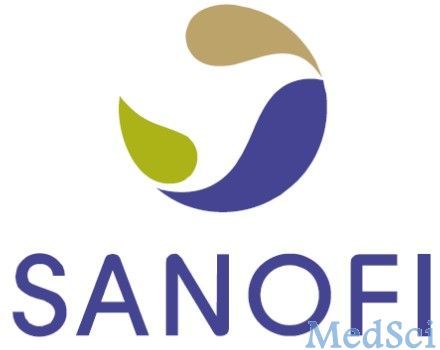5年磨一剑,赛诺菲颠覆性口服戈谢病药物Cerdelga获欧盟批准
2015-01-23 佚名 生物谷
赛诺菲(Sanofi)颠覆性口服戈谢病药物Cerdelga(eliglustat)近日如愿获得欧盟批准,用作特定1型戈谢病(Gaucher disease)成人患者的一线口服疗法。在美国,Cerdelga于2014年8月获得FDA批准。Cerdelga不适用于经基因检测(CYP2D6)证实对Cerdelga代谢更快或代谢速度不确定的少数患者。赛诺菲计划从2015年开始陆续将Cerdelga推向
赛诺菲(Sanofi)颠覆性口服戈谢病药物Cerdelga(eliglustat)近日如愿获得欧盟批准,用作特定1型戈谢病(Gaucher disease)成人患者的一线口服疗法。在美国,Cerdelga于2014年8月获得FDA批准。Cerdelga不适用于经基因检测(CYP2D6)证实对Cerdelga代谢更快或代谢速度不确定的少数患者。赛诺菲计划从2015年开始陆续将Cerdelga推向欧盟成员国市场。
目前,酶替代疗法(ERT)是戈谢病的标准治疗方案,患者需终身定期(每2周注射一次)接受静脉输注。业界预测,Cerdelga作为首个口服治疗药物,将完全颠覆当前依赖注射型药物的戈谢病市场格局,成为1型戈谢病群体的一个重要新治疗选择。
赛诺菲花了足足15年时间,终于研制成功首个口服戈谢病药物Cerdelga,该药的临床项目,是有史以来在戈谢病群体中开展的最大规模临床项目,涉及29个国家约400例患者。III期项目中,Cerdelga在2个试验中均成功稳定了病情:其中一项安慰剂对照研究在初治患者中开展,另一项研究则证明了Cerdelga对酶替代疗法Cerezyme的非劣效性。
Cerezyme(注射用伊米苷酶,imiglucerase)是赛诺菲旗下罕见病单元健赞(Genzyme)在20多年前推出的全球首个戈谢病治疗药物,也曾一度是全球最昂贵的药物,治疗成本高达30万美元/年。过去多年,Cerezyme一直统治戈谢病市场。业界预测,口服药物Cerdelga将大肆瓜分Cerezyme的市场份额,同时将与另2种注射药物——夏尔(Shire)的Vpriv和辉瑞(Pfizer)的Elelyso展开竞争。据彭博社分析,到2020年,Cerdelga的年销售额将达到7.49亿美元。目前,Cerezyme的年销售额约为9.16亿美元。
Cerdelga是一种强效、高度特异性神经酰胺类似物抑制剂,靶向葡萄糖神经酰胺合成酶(glucosylceramide synthase, GCS),能够降低葡萄糖神经酰胺的产生。Cerdelga适用于肝脏药物代谢酶细胞色素P450 2D6(CYP2D6)代谢基因型为弱代谢(poor metabolizers,PMs)、中等代谢(intermediate metabolizers,IMs)、快代谢(extensive metabolizers,EMs)的1型戈谢病成人患者的长期治疗,但不适用于超速代谢者(ultrarapid metabolizers,UMs)。
Cerdelga的获批,对戈谢病群体是一个大好消息,无论从科学和临床角度来看,该药作为一种一线口服药物,已被证明具有积极的风险/利益属性。酶替代疗法(ERT)能够降解沉积在细胞中的脂肪沉积物并会引起各种症状,而Cerdelga则能够直接抑制脂肪沉积物在细胞中的积累。
戈谢病(Gaucher Disease)是一种常染色体隐性遗传所造成的葡糖脑苷脂沉积症,主要是因编码葡萄糖脑苷酯酶(glucocerebrosidase) 的结构基因突变,导致该酶缺乏,致使巨噬细胞内的葡萄糖脑苷脂不能被进一步水解而堆积在溶酶体中,导致细胞失去原有的功能。这些病理性细胞在人体器官中的浸润会造成骨骼、骨髓、脾脏、肝脏和肺部的病变。目前,全球仅有1万名戈谢病患者,美国患者总数约为6000人。
英文原文:European Commission Grants Marketing Authorzation for Cerdelga® (eliglustat), Genzyme’s Oral Therapy for Gaucher Disease Type 1
CAMBRIDGE, Mass.--(BUSINESS WIRE)--
Genzyme, a Sanofi company, announced today that the European Commission (EC) has granted marketing authorization for Cerdelga® (INN:eliglustat) capsules, a first line oral therapy for certain adults living with Gaucher disease type 1. A small number of adult patients who metabolize Cerdelga more quickly or at an undetermined rate, as detected by an established genetic laboratory test, will not be eligible for Cerdelga treatment. Cerdelga was approved by the U.S. Food and Drug Administration in August 2014, and is under review by other regulatory authorities around the world. It is expected that Cerdelga will be available commercially in EU countries beginning in 2015 and over the next few years.
Cerdelga is a potent, highly specific ceramide analogue inhibitor of glucosylceramide synthase with broad tissue distribution including to bone marrow. It reduces the production of glucosylceramide, the substance that builds up in the cells and tissues of people with Gaucher disease type 1. Cerdelga is indicated in the European Union for the long-term treatment of adult patients with Gaucher disease type 1 (GD1), who are CYP2D6 poor metabolizers (PMs), intermediate metabolizers (IMs) or extensive metabolizers (EMs).
The majority of adverse reactions of Cerdelga are mild and transient. The most commonly reported adverse reaction with Cerdelga is diarrhea, in approximately 6% of the patients. The incidence of diarrhea was the same or higher with placebo than with Cerdelga in the placebo-controlled pivotal study. Less than 2% of patients receiving Cerdelga permanently discontinued treatment due to any adverse reaction.
The EC approval was based on data from the Cerdelga clinical development program, the largest clinical research program ever conducted in Gaucher disease type 1, with approximately 400 patients treated in 29 countries. The development program included two pivotal Phase 3 clinical trials. In a Phase 3 placebo-controlled trial (ENGAGE, a study in treatment-naïve patients with Gaucher disease type 1) improvements were seen across the following endpoints after 9 months on Cerdelga: spleen size, platelet levels, hemoglobin levels, and liver volume. The second Phase 3 trial was designed to assess disease stability in patients previously treated with enzyme replacement therapy (ENCORE). That trial met the pre-specified criteria for non-inferiority to an enzyme replacement therapy (imiglucerase), which was a composite endpoint of each of the following parameters: spleen volume, hemoglobin levels, platelet counts, and liver volume. Patients in the registration studies continued to receive Cerdelga in the extension periods, and the majority of patients are in their 4th or 5th year of treatment. In a Phase 2 clinical study in treatment-naïve patients, Cerdelga has shown a positive effect on bone parameters including Bone Marrow Burden (BMB) and Bone Mineral Density (BMD) which was sustained over a period of at least 4 years. The majority of Phase 2 patients in the extension period are now in their 8th year of treatment.
About Gaucher Disease
Gaucher disease is an inherited condition affecting fewer than 10,000 people worldwide. People with Gaucher disease do not have enough of an enzyme, acid β-glucosidase (glucocerebrosidase) that breaks down a certain type of fat molecule. As a result, lipid engorged cells (called Gaucher cells) amass in different parts of the body, primarily the spleen, liver and bone marrow. Accumulation of Gaucher cells may cause spleen and liver enlargement, anemia, excessive bleeding and bruising, bone disease and a number of other signs and symptoms. The most common form of Gaucher disease, type 1, generally does not affect the brain.
About Cerdelga
Cerdelga (eliglustat), a novel glucosylceramide analog given orally, was designed to partially inhibit the enzyme glucosylceramide synthase, which results in reduced production of glucosylceramide. Glucosylceramide is the substance that builds up in the cells and tissues of people with Gaucher disease. The concept was initially developed by the late Norman Radin, PhD, from the University of Michigan. In pre-clinical studies, the molecule, developed with James A. Shayman, MD, also from the University of Michigan, showed specificity for glucosylceramide synthase. Following an extensive pre-clinical and early clinical research program, Cerdelga was studied in the largest Phase 3 clinical program ever conducted in Gaucher disease.
Cerdelga is registered as an orphan medicinal product for the treatment of Gaucher disease in the Community Register of Orphan Medicinal Products.
EU indication and Usage
Cerdelga is indicated for the long-term treatment of adult patients with Gaucher disease type 1 (GD1), who are CYP2D6 poor metabolizers (PMs), intermediate metabolizers (IMs) or extensive metabolizers (EMs).
Important Safety Information about Cerdelga for EU patients
Cerdelga is contraindicated in patients who are CYP2D6 intermediate metabolizers (IMs) or extensive metabolizers (EMs) taking a strong or moderate CYP2D6 inhibitor concomitantly with a strong or moderate CYP3A inhibitor, and in patients who are CYP2D6 poor metabolizers (PMs) taking a strong CYP3A inhibitor. Under these conditions both major metabolic pathways for eliglustat metabolism are impaired, with predicted substantially elevated eliglustat plasma concentrations. Although no significant QTc increases were seen in a thorough QT study in healthy volunteers, based on PK/PD modelling, eliglustat plasma concentrations 11-fold the predicted human Cmax are predicted to cause mild increases in the PR, QRS, and QTc intervals.
Use of Cerdelga in patients with pre-existing cardiac conditions has not been studied during clinical trials. Because eliglustat is predicted to cause mild increases in ECG intervals at substantially elevated plasma concentrations, use of Cerdelga should be avoided in patients with cardiac disease (congestive heart failure, recent acute myocardial infarction, bradycardia, heart block, ventricular arrhythmia), long QT syndrome, and in combination with Class IA (e.g. quinidine) and Class III (e.g. amiodarone, sotalol) antiarrhythmic medicinal products.
Patients should be regularly monitored for clinical response.
The most common side effects of Cerdelga (>2% of patients) are headache, nausea, diarrhoea, abdominal pain, flatulence, arthralgia, and fatigue. The most frequently reported serious adverse reaction in clinical studies was syncope (0.76%). All events were associated with predisposing risk factors and appeared to be vasovagal in nature. None of these events led to discontinuation from the study.
Prescribing information and more information about Cerdelga for EU patients will be available shortly at: http://ec.europa.eu/health/documents/community-register/html/index_en.htm.
For full prescribing information and more information about Cerdelga for U.S. patients, please visit: http://www.cerdelga.com/pdf/cerdelga_prescribing_information.pdf.
本网站所有内容来源注明为“梅斯医学”或“MedSci原创”的文字、图片和音视频资料,版权均属于梅斯医学所有。非经授权,任何媒体、网站或个人不得转载,授权转载时须注明来源为“梅斯医学”。其它来源的文章系转载文章,或“梅斯号”自媒体发布的文章,仅系出于传递更多信息之目的,本站仅负责审核内容合规,其内容不代表本站立场,本站不负责内容的准确性和版权。如果存在侵权、或不希望被转载的媒体或个人可与我们联系,我们将立即进行删除处理。
在此留言











#欧盟批准#
72